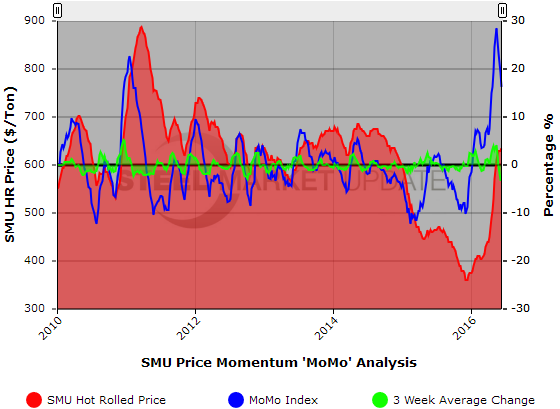SMU Data and Models

SMU HR Price MoMo Index Indicating Pace of Increases Slowing
Written by Brett Linton
June 9, 2016
There are two headlines when reviewing our MoMo Index this week. The first is our Index has been in positive territory for 23 consecutive weeks. The second is showing the relationship in the current price movement compared against the 12 week moving average is in decline. That steep rise we saw earlier is pulling back (see graphic below).
The Steel Market Update (SMU) Price Momentum Index (MoMo) for hot rolled steel in the United States remained positive for the 23rd consecutive week, following a 21 week negative streak. MoMo is a trailing indicator and shows the relationship between the current U.S. hot rolled coil price movements against the previous 12-week average price as a percentage. A positive MoMo index indicates hot rolled steel prices are moving in an upward direction compared to the previous 12 week period, while a negative index number indicates a downward direction of prices.
MoMo should not be confused with the SMU Price Momentum Indicator which is a forward looking indicator and is currently pointing toward higher pricing over the next 30 to 60 days.
MoMo was measured at 16.34 percent this week, meaning that the current HRC price is higher than the average price over the last 12 weeks.
The change in MoMo can be a useful indicator in depicting the severity of price movements and evaluating the directional trend for flat rolled steel prices. The week-over-week change in MoMo was -2.81 percent, following a change of -4.18 percent last week. This indicates that the hot rolled price movement is slowing down but at a slightly slower rate than what we measured last week.
To get a wider sense of the change in the MoMo Index and eliminate weekly fluctuations, we calculate a 3-week average change. The 3-week average change in the MoMo Index is -3.18 percent, following a change of -3.13 percent the week before. This also shows that the movement in hot rolled prices is decelerating and at at an almost identical rate compared to the previous 3-week period.
The graph below demonstrates the relationship between the SMU hot rolled coil price, the SMU Price MoMo Index, and the three week moving average change in the MoMo Index. As published in our Tuesday evening issue, the SMU HRC price range for this week is $620-$650 per ton with an average price of $635, up $5 per ton from last week.
You may want to take a few moments to study this graph, especially those periods of time when there have been sharp spikes in pricing. Our index follows those spikes but we find it interesting that the steep drop after the peak on a number of occasions proceeds the actual price drop. A warning for steel buyers perhaps?

Brett Linton
Read more from Brett LintonLatest in SMU Data and Models

SMU Survey: Sheet lead times ease further, plate hits one-year high
Steel buyers responding to this week’s SMU market survey report a continued softening in sheet lead times. Meanwhile, plate lead times have moderately extended and are at a one-year high.

SMU Survey: Buyers report more price flexibility from mills
Nearly half of the steel buyers responding to this week’s SMU market survey say domestic mills are showing increased willingness to negotiate pricing on new spot orders. This marks a significant shift from the firmer stance mills held in prior weeks.

SMU Survey: Buyers’ Sentiment Indices fall
Current Sentiment Index dropped six points to +42 this week compared to two weeks earlier. It has fallen in every successive survey since reaching a 2025 high of +66 on Feb. 19.

March service center shipments and inventories report
Steel service center shipments and inventories report through March 2024.

Apparent steel supply contracts in February
The amount of finished steel that entered the US market in February receded from January’s peak, according to our analysis of Department of Commerce and American Iron and Steel Institute (AISI) data.

